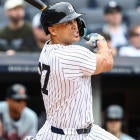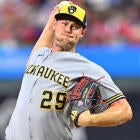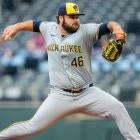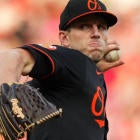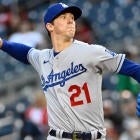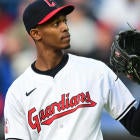Note: FanDuel is hosting a one-day Fantasy Baseball league tonight. It's $5 to enter and pays out $100,000 in cash prizes. First place wins $10,000. Sign up now!
The calendar has turned to June, which means we have made it through close to one-third of the season. Many everyday players have appeared in 50 games or more by now, and yet if you've been holding on to some disappointing hitters, you're probably hoping that the season-to-date sample is small enough as to not have much to say about our rest-of-season expectations.
Much stranger things have happened in baseball than a 50-game cold snap. Your slumping player just might be this season's version of Matt Kemp and Buster Posey, both of whom woke up sometime after Memorial Day last season.
While there is no foolproof way to determine whether your sleeping giant is about to wake up, a deeper look into the peripheral stats can give us a better idea whether it makes sense to maintain optimism. If you've been stubbornly starting your slumping studs, it could be time to bench them. If you're in a shallower format, your best move could be to hand their roster spot -- even if it's on the bench -- to someone who has been performing better.
Among hitters, there have probably been no bigger early-season disappointments than Kemp (again) and Robinson Cano. My colleague, Chris Towers, did a tremendous job breaking down Kemp's breakdown in a recent blog post, detailing the various ways that his lack of power has manifested itself statistically. Cano's case is a little different from many of the other underachievers, in that his diminished power doesn't represent a sea change from 2014. For Cano, the biggest difference is that pitchers are no longer afraid to pitch to him in the zone, so he's getting fewer walks and more called strikes.
Even though Kemp and Cano were both early-round picks, both have struggled to the point where they should be benched in standard mixed leagues. But are the signs as clear for other persistent slumpers, like Troy Tulowitzki, Jason Heyward and Melky Cabrera? We'll take a deeper look at them among a handful of hitters who have been giving their Fantasy owners fits for eight solid weeks.
Note: Stats are current for games played through Tuesday, June 2.
Troy Tulowitzki, SS, Rockies
Tulowitzki has returned from hip surgery a markedly different hitter -- one who has been far more aggressive than in the past. In the season's early weeks, Tulowitzki was chasing pitches out of the zone more often and pulling the ball more frequently when he made contact. At the end of April, he sported an .847 OPS, and while that's a little off the pace that Tulowitzki has set over the course of his career, owners likely had few complaints about getting that level of production from their shortstop.
Since then, Tulowitzki has moderated his pull tendencies but not his itchy trigger at the plate. The result has been a surge in his strikeout rate and a serious across-the-board dip in his slash line stats (.269/.289/.419 since May 1). Even though health issues haven't been a concern, Tulowitzki ranks just 10th in Fantasy points and sixth in Rotisserie value among shortstops. Only four players have a lower BB/K ratio than Tulowitzki's 0.13, and unless he improves it, he is operating with a very thin margin of error. With that kind of plate discipline, Tulowitzki could produce like an elite shortstop again, but only if he can make contact more frequently and pull flyballs more often. That may be asking too much.
Jorge Soler, OF, Cubs
As Soler breezed through the Cubs' minor league system, one of the more promising signs was that he was able to keep his strikeout rate in check at every level. When the Cubs promoted him late last season, he was a little more prone to whiffing, but that was to be expected with his first exposure to major league pitching. While a 27 percent rate of strikeouts per at-bats is on the high side of average, it was practically miniscule in comparison to those of many other young sluggers, like Javier Baez, George Springer and Jon Singleton.
Instead of regressing back towards his more modest minor league strikeout rates, Soler has sent his K-rate soaring this season. Through his first 49 games, Soler has struck out in 35 percent of his at-bats, which has limited his batting average to .265. When you realize he has been batting .302 on grounders, you may consider Soler lucky to have an average that high, but that's only part of the story. When he has made contact, he has been hitting to all fields, so the high batting average on grounder just may be sustainable. The same may not be said for Soler's 35 percent line drive rate, but that probably does speak to how hard he has been hitting the ball.
Soler's bid for a turnaround will have to wait until his sprained ankle heals and he is activated from the 15-day disabled list. As his game is constituted right now, Soler won't be worth starting in three-outfielder leagues once he returns, and he will be fringy in five-outfielder formats. However, if he can continue to spray the ball with authority while making more frequent contact, we could see a dramatic breakout. In the hopes that it occurs sometime this season, he's worth a buy-low attempt.
Melky Cabrera, OF, White Sox
Even when Cabrera frustrated Fantasy owners with his down 2013 season -- his first year with the Blue Jays -- it was nowhere near as bad as what he is putting them through now. Two seasons ago, Cabrera managed only three home runs but did notch 15 doubles and two triples in 88 games, and in retrospect, that diminished production was likely related to him playing with a tumor near the base of his spinal cord. Through 49 games, Cabrera has a single home run accompanied by four lonely doubles. His .034 Isolated Power is the lowest among qualifying hitters, "besting" that of Eric Sogard, Freddy Galvis and Juan Lagares.
There is nothing wrong with Cabrera's plate discipline, and he has actually increased his contact rate. He simply isn't hitting the ball hard. According to FanGraphs, Cabrera's hard contact rate has dropped from 30.5 percent a year ago to 19.8 percent this season. It's not yet clear why Cabrera has been so devoid of power, but his dearth of extra-base hits has been extreme enough that he should no longer be owned in three outfielder leagues. He could even be worth dropping in standard mixed five outfielder formats as well.
Danny Santana, SS/OF, Twins
Plenty of Fantasy owners were skeptical about Santana repeating last season's .319 batting average, but there was good reason to expect that he could still provide 20-plus steals and some doubles power. A .260 batting average also seemed like a realistic expectation, but some abysmal plate discipline has led to an increase in strikeouts, and he's pulling too many ground balls. That's how he has landed at a .222 batting average through his first 45 games.
But wait, it gets worse. Santana has never been a patient hitter, he has been aggressive to a fault this season. Santana's average number of pitches per plate appearance has plunged from 3.81 to 3.39, and no one in the majors has a lower walk rate. His two walks to date have left him with a mere 1.1 percent walks over his 175 plate appearances. With Santana's lack of plate discipline being at the core of so many problems, it's entirely possible that he is still overowned, even though his ownership rate has dipped to 43 percent.
Anthony Gose, OF, Tigers
With a .417 BABIP and .304 overall batting average, Gose looks like a regression candidate, and that's even after he has undergone a 1 for 19 skid. A falling batting average isn't the only thing endangering Gose's Fantasy value. With eight stolen bases in 13 attempts, he is resurrecting a trend we have seen previously in Gose's career. Over the previous two seasons, Gose had stolen 43 bases during his stints in Triple-A, but he had also been caught 21 times. Getting tossed out in roughly one out of every three stolen base attempts is sufficiently inefficient that you have to wonder if Tigers manager Brad Ausmus will use the green light on Gose more sparingly.
Gose is not the majors' only inefficient base stealer, but among those in similar company (e.g., Ender Inciarte, Steven Souza, Jason Kipnis), he is unique in that he has a history of inefficiency and relies on steals for a great deal of his Fantasy value. It looks like a good time to deal Gose before the erosion to his stolen base rate and batting average starts to take root.
Jason Heyward, OF, Cardinals
Heyward is still just 25, so we can't rule out the possibility of a breakout, but now that he is in the midst of his third straight season with modest power numbers for an outfielder, it might be time to give up the idea that he will be a 20/20 threat. What is most discouraging is that Heyward has been moving in the wrong direction this season in a number of different ways. His ground ball rate has climbed from 46 percent in 2014 to 57 percent in 2015, he is swinging at pitches outside the zone more often and making contact with those pitches less frequently. It was a neat trick for Heyward to be the only batter so far this season to homer off ground ball pitcher extraordinaire Brad Ziegler, but each of Heyward's other four home runs came off pitchers who have struggled with the long ball.
With suspect power numbers and questionable plate discipline, Heyward appears to be someone who can only be trusted with extremely good matchups. That's not good enough for him to merit a roster spot in a mixed three outfielder league, but the potential for a turnaround makes him worth stashing in five outfielder leagues.













